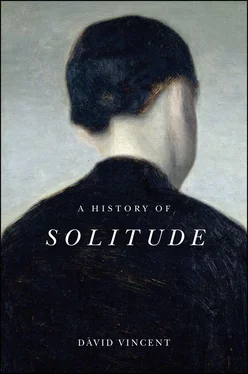John Naughton has supplied networked support through the projects of the Cambridge Centre for Research in the Arts, Social Sciences and Humanities. I thank him for his encouragement and hospitality, as well as his unrivalled expertise on the digital revolution and its implications. The visiting fellows at CRASSH have been a source of debate and information. Colleagues at the Open University have read and commented on draft chapters and made available their specialized knowledge, with particular thanks to Amanda Goodrich, Ros Crone, and John Wolffe. I have benefited from discussions with Patrick Joyce, Leslie Howsam, Kathryn Hughes, and Isabel Rivers. Andrew Mackenzie-McHarg and Anne Vila helped me understand Johann Zimmermann and his writings. Claudia Hammond lent me material from her impressive BBC/Welcome Trust collaborations. The progress of this project has been discussed in the generous company of Brenda and James Gourley, and Seija and Graham Tattersall. Charlotte Vincent, as so often over so many years, has been a sustaining critic, arguing through the book’s ideas, supporting its labour and reading every word for accurate expression. At Polity, Pascal Porcheron’s persistent enthusiasm for this project has much to do with its completion. The care given by Justin Dyer to the preparation of this text has been exemplary.
This book has been researched in the deep quiet of the rare books rooms in the British Library and the Cambridge University Library, and I thank their staff for their patience and efficiency. As the project was commencing one Armistice Day, the public address system in the latter’s Rare Books Room made the oddly unfeasible request of its readers that they observe a silence for the fallen. Even in the depths of a library, solitude has to be managed.
The book was written in a converted pigsty in my garden. It is twenty steps from my desk to my house, from my own company to that of my wife and the intermittent presence of children, grandchildren and friends. To be able to make that journey from one location to the other, from productive solitude to the most profound sociability, is the privilege of my life.
A History of Solitude is dedicated to Veronica Weedon née More, to whom I had the good fortune of being related by marriage. After an eventful war-service, which included work at Bletchley Park, she married and had a family, but was early widowed. Her subsequent life throughout nearly six decades, latterly in a mountain village in Majorca, was an exemplary demonstration of how to maintain a balance between her own company and a wide range of family, friends, and outside interests. She was a great reader, and in turn the author of four books, the first published when she was eighty-five. I hope she would have enjoyed this one.
Shrawardine, autumn 2019
1 INTRODUCTION: SOLITUDE CONSIDERED
‘Zimmerman on Solitude’
In 1791, the first full-length study of solitude for more than four centuries was published in England. Solitude Considered with Respect to its Dangerous Influence Upon the Mind and Heart was a shortened translation of the four-volume Über die Einsamkeit , written in 1784 and 1785 by Johann Georg Zimmermann, personal physician to George III in Hanover and to the late Frederick the Great. The book was not universally welcomed. ‘An essay on solitude, in 380 pages,’ grumbled the Gentleman’s Magazine , ‘seems to require confinement in a solitary cell to read it.’ 1But there were plenty of purchasers prepared to undertake the challenge. It was an immediate publishing success, generating further editions and competing translations annually during the 1790s, and a scattering of reprints in the first third of the following century. 2‘Zimmerman on Solitude’, widely available on second-hand bookstalls, became part of the literary furniture of the modernizing society. 3
The topic was inherently controversial. ‘Various are the opinions concerning Solitude,’ observed the Critical Review in its response to the publication. ‘By some it is considered as the parent of all human excellence and felicity; by others, as the depraver of the faculties, and the source of disquietude: and those who can endure it have been stated to be either above or below the standard of humanity.’ 4Early English versions of Zimmermann’s book, which omitted much of the criticism of solitude, led to a popular misconception that it was a mere celebration of retirement. 5However Zimmermann’s powerfully argued treatise was a much more complex document. Throughout the book he addressed the task of balancing ‘all the comforts and blessings of Society’ with ‘all the advantages of Seclusion’. 6Neither way of living was sufficient in itself, or invulnerable to destruction by its opposite. ‘When we scrutinise its calamitous operation in the cloister and the desert,’ Zimmermann wrote, ‘we shall revolt with horror from the lamentable and hateful spectacle; and acknowledge ourselves fully persuaded, that, if the proper condition of man does not consist in a promiscuous and dissipated commerce with the world, still less does he fulfil the duties of his station, by a savage and stubborn renunciation of their society.’ 7
The proper condition of man, and woman, is the subject of this history. It seeks to understand how people over the last two centuries have conducted themselves in the absence of company. Zimmermann’s treatise was a way station in a debate about social engagement and disengagement that stretches back to classical times and has acquired new urgency in our own era. 8Current anxieties about the ‘loneliness epidemic’ and the fate of interpersonal relations in the digital culture are reformulations of dilemmas that have surfaced in prose and verse for more than two millennia. In selecting the topic of his magnum opus , itself an expanded version of a shorter study of 1755–6, Zimmermann made no claim to originality. He was engaging with a range of authorities, particularly Petrarch’s The Life of Solitude , written between 1346 and 1356, and published as a book just over a century later. 9Petrarch was conducting a discussion with early and pre-Christian authorities, and Zimmermann in turn was seeking to re-focus rather than invent the subject. He was a Swiss German with a French-speaking mother, widely read in English as well as his native languages, and conversant with the numerous eighteenth-century treatments of the topic in novels and poetry. 10His book was rapidly translated because both its subject matter and its evidential frame of reference were familiar to any educated European of the period. It stood in the mainstream of one of the longest debates in Western culture and at the same time constituted a critical reaction to a period of unprecedented change. Zimmermann was deeply immersed in the urban bourgeois society that was beginning to recognize itself as an historical force, and in his old age witnessed the French Revolution taking place on the other side of his native Jura.
The point of departure and return in Solitude Considered was what Zimmermann termed ‘social and liberal intercourse’. 11Despite a personal predilection for withdrawal, he was sympathetic to the Enlightenment endorsement of social exchange as the engine of cultural and mental progress. As one of Europe’s leading medical practitioners, he was professionally committed to physical engagement with his patients. Theoretical explanations, learned and advanced in the closet, were not sufficient. Effective treatment of sickness required direct observation and accumulated practical experience. 12Zimmermann’s emphasis on social contact constituted a description of his own methods and achievement:
The best and sagest moralists have ever sought to mix with mankind; to review every class of life; to study the virtues, and detect the vices, by which each are peculiarly marked. It has been by founding their disquisitions and essays on men and manners, upon actual observation, that they have owed much of the success, with which their virtuous efforts have been crowned. 13
Читать дальше












